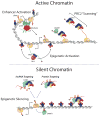Long noncoding RNAs in cell-fate programming and reprogramming
- PMID: 24905165
- PMCID: PMC4120821
- DOI: 10.1016/j.stem.2014.05.014
Long noncoding RNAs in cell-fate programming and reprogramming
Abstract
In recent years, long noncoding RNAs (lncRNAs) have emerged as an important class of regulators of gene expression. lncRNAs exhibit several distinctive features that confer unique regulatory functions, including exquisite cell- and tissue-specific expression and the capacity to transduce higher-order spatial information. Here we review evidence showing that lncRNAs exert critical functions in adult tissue stem cells, including skin, brain, and muscle, as well as in developmental patterning and pluripotency. We highlight new approaches for ascribing lncRNA functions and discuss mammalian dosage compensation as a classic example of an lncRNA network coupled to stem cell differentiation.
Copyright © 2014 Elsevier Inc. All rights reserved.
Figures



References
Publication types
MeSH terms
Substances
Grants and funding
LinkOut - more resources
Full Text Sources
Other Literature Sources

